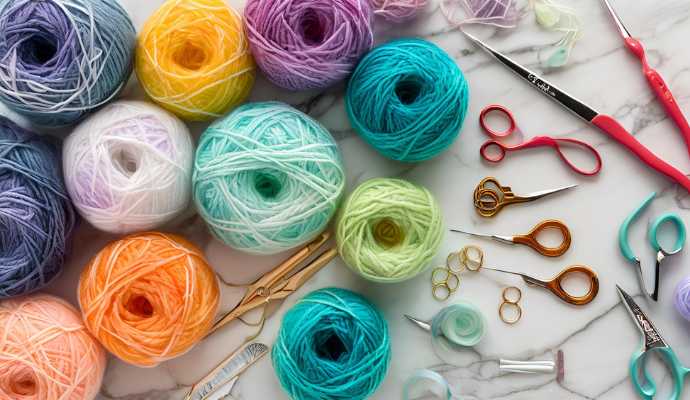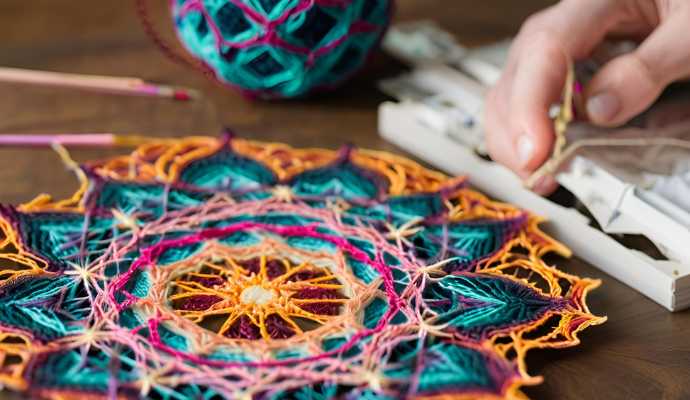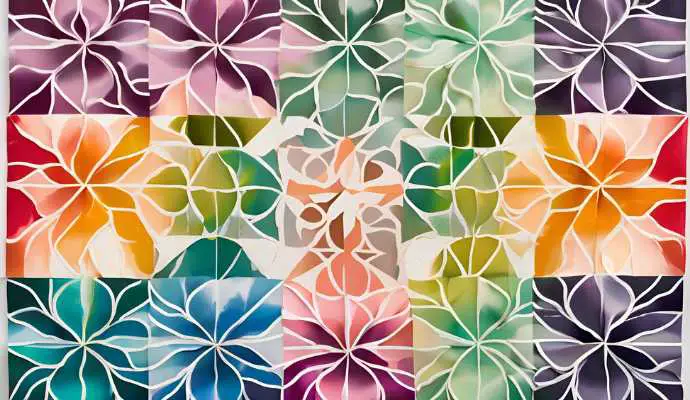The Asteria Crochet Pattern is designed for beginners but is suitable for crafters of all skill levels, and it can be accessed through a PDF download. It provides detailed instructions on the necessary materials, guidance on how to read the pattern, stitch tutorials, and general tips for crocheting, including video tutorials for visual learners. This versatile pattern can be used to create a variety of items, such as a blanket, scarf, headband, mandala, doily, or bag, making it an excellent choice for a wide range of crafters.
Key Takeaways:
- The Asteria crochet pattern is a versatile and timeless design that can be used to create various items such as blankets, scarves, hats, doilies, and bags.
- When crocheting the Asteria pattern, it is important to have the necessary materials such as yarn, crochet hook, scissors, stitch markers, and tapestry needle, which are all specified in the material specifications section.
- To successfully crochet the Asteria pattern, it is crucial to understand the abbreviations and read the stitch diagrams. Counting stitches and using stitch markers can also help with accuracy.
What is the Asteria Crochet Pattern?
The Asteria Crochet Pattern, designed by Alla Chikalova, is an intricate and beautifully crafted crochet project that is perfect for crafters eager to explore unique patterns and enhance their crocheting skills. The pattern is available on Boosty, offering creative inspiration for both new crocheters and experienced crafters.
This pattern is notable for its elegant design and versatility, enabling crafters to create stunning shapes suitable for a variety of applications, from doilies to mandalas and wall hangings.
Featuring step-by-step tutorials and video tutorials, the Asteria pattern is ideal for both beginners and experienced crocheters looking to add complexity to their projects.
What Materials Do You Need for the Asteria Crochet Pattern?
To complete the Asteria Crochet Pattern, you will need Alize Bella yarn, Polyester Cord, cotton thread, and tools such as a 1.75 mm crochet hook.
These materials are essential for achieving the desired finished size and ensuring the integrity of the intricate pattern. This section outlines the necessary supplies for this project, including material specifications for each item.
1. Yarn
Using high-quality yarns like Alize Bella Ombre Batik and 100% cotton thread ensures a beautiful crafted beauty that is structurally sound and aesthetically pleasing.
Choosing the right yarn is crucial for the Asteria crochet pattern. High-quality yarns, such as Alize Bella and 100% cotton thread, ensure that the finished project is both aesthetically pleasing and structurally sound. Alize Bella Ombre Batik offers a gradient effect that adds depth to the project.
Yarns that feel soft against the skin and come in a wide range of colors provide ample opportunities for imaginative designs. By selecting colors that blend seamlessly into one another, you can create contrasting or harmonious effects that enhance the visual appeal of the piece.
Alize Bella offers the softness needed for comfort while also possessing the strength required for intricate designs. When selecting cotton threads, it’s important to consider their breathability and ease of maintenance, as these qualities contribute to both the aesthetic and functional aspects of the Asteria crochet piece.
2. Crochet Hook
The Asteria crochet pattern requires a 1.75 mm crochet hook. The type and size of the crochet hook significantly influence the finished size of the project, as well as the tension and ease of crafting. For larger pieces, a 4.50 mm hook can also be used depending on the desired effect.
A smaller crochet hook creates tighter stitches, allowing the intricate details of the Asteria Free Crochet Pattern to stand out and giving the work a crisp, polished appearance.
Experimenting with different hooks can help crocheters of all skill levels discover their preferred size and shape. Some may favor ergonomic hooks that alleviate hand strain, while others may seek specific properties associated with metal or bamboo hooks.
Finding the ideal hook enhances the crafting experience, making it more enjoyable and fulfilling.
3. Scissors
Scissors are a fundamental yet essential tool in the crochet crafting process, enabling you to cut yarn cleanly and efficiently when finishing the Asteria crochet pattern. Using sharp, precise scissors ensures clean cuts for a polished finish.
Using the right pair of scissors can significantly enhance your overall crafting experience, transforming the tasks of weaving in ends or trimming excess yarn into more enjoyable activities.
Scissors with sharp, precision blades and a comfortable, ergonomic grip not only promote accuracy but also help to reduce hand fatigue during long crafting sessions.
Additionally, small-sized scissors are easier to maneuver around intricate stitches and can fit snugly into your crochet toolkit.
4. Stitch Markers
Stitch markers play a crucial role in tracking progress and maintaining the integrity of the Asteria crochet pattern, as they help keep crocheters organized. They serve as visual reminders of important stitch points, making it easier to count stitches and stay aligned with the pattern’s flow.
When working on complex designs, marking increases, decreases, and repeats is essential to avoid making significant errors. Many crocheters prefer to use removable stitch markers for areas that will change, while others find that locking stitch markers help secure the number of stitches.
For both beginners and experienced crocheters, using brightly colored or uniquely shaped markers enhances visibility and adds a personal touch.
5. Tapestry Needle
A tapestry needle is essential for completing crochet projects, as it is used to weave in ends and secure stitches when finishing the Asteria crochet pattern. Using the appropriate size, such as a size 18 or 20 needle, is crucial for working with cotton thread and yarn.
Selecting the right tapestry needle enhances both the crochet and overall crafting experience, ensuring that the work is finished properly and that stitches remain secure.
The size of the needle is important; for cotton threads and yarn, a size 18 or 20 needle is typically recommended. This size features a larger eye that accommodates thicker fibers without being so large that it damages the delicate strands.
Additionally, choosing a tapestry needle with a blunt tip is crucial to prevent splitting the yarn as it is pulled through the stitches. Using the appropriate tapestry needle not only contributes to a polished finish but also helps maintain the integrity of the crochet designs, ultimately leading to greater satisfaction with each completed project.
How to Read the Asteria Crochet Pattern?
Understanding how to read the Asteria crochet pattern is essential for successfully creating this intricate design. The pattern includes important abbreviations and stitch charts that guide makers through each stage of the process. This pattern has received 4.9 overall rating from 68 votes, indicating its clarity and ease of use.
1. Understanding the Abbreviations
The Asteria crochet pattern incorporates various abbreviations to streamline the instructions, making it essential for crafters to familiarize themselves with these terms for a smoother crafting experience.
By understanding common abbreviations such as SC for single crochet, DC for double crochet, and CH for chain, crafters can easily decode the pattern without getting lost in lengthy descriptions.
Familiarity with stitches like HDC (half double crochet) and STS (stitches), as well as terminology such as RND (round) and RS (right side), significantly enhances the crocheting process.
When navigating the Asteria pattern, knowing these terms allows creators to concentrate on their stitches rather than struggling to interpret the instructions. Ultimately, this knowledge fosters confidence and enjoyment, enabling enthusiasts to see their crochet projects come to life with greater ease.
2. Reading the Stitch Diagrams
Stitch diagrams are an excellent resource for crocheters, particularly for understanding complex patterns such as the Asteria crochet pattern. They simplify instructions for visual learners, making the crocheting process more accessible. The Asteria pattern also includes video tutorials for those who prefer visual instructions.
By translating written instructions into graphical symbols, stitch diagrams provide clarity and enhance the crocheting experience, allowing visual learners to better grasp the flow of stitches and how various components fit together.
Using stitch diagrams in conjunction with written instructions is especially beneficial for those working on the Asteria pattern, as they offer a more comprehensive understanding of the project.
It is advisable to refer to the diagram regularly throughout the project to ensure that each stitch is placed correctly, which can help minimize mistakes and improve the overall quality of the finished product.
How to Crochet the Asteria Pattern?
The Asteria pattern is an advanced crochet project that involves multiple rounds, starting with a magic ring. It offers a unique project for those looking to challenge their crocheting skills and create a crafted beauty that stands out.
It consists of several intricate steps to complete the design.
1. Starting with the Magic Ring
The magic ring technique is especially useful for projects like the Asteria mandala, where a tight center is crucial for the overall structure.
The Asteria crochet pattern begins with a magic ring (also known as a magic circle or adjustable loop) to create a tight center from which the rest of the design will grow, providing a sturdy base for the project.
This magic ring technique helps achieve a neat finish and ensures that the center of the piece remains tight, preventing any holes in the design.
To create a magic ring, wrap the yarn around your fingers and cross it to form an ‘X’. Then, use the crochet hook to pull the working yarn through the loop and chain once to secure it.
After that, you can work the necessary stitches into the ring, adjusting the tension as needed to ensure a uniform finish for the project.
Using the magic ring method with the Asteria pattern will help produce a consistent finish, which is essential for all crocheted pieces. For additional guidance, refer to video tutorials that demonstrate this technique in detail.
2. Creating the First Round
The first round of the Asteria crochet pattern begins after establishing the magic ring and is the initial step in a series of three rounds that lead to more intricate designs that follow. This pattern offers an easy-to-follow guide that new crocheters will find manageable yet challenging enough to enhance their skills.
- The first round shapes the entire piece, forming beautiful shapes that resemble a multi-layered doily.
- You will need to place stitches in the ring, typically using either a single crochet or double crochet stitch, depending on the specific pattern.
- It’s important to keep track of the number of stitches you place, as it can be easy to lose count during this step.
- Maintain even tension throughout the round by holding the yarn comfortably and avoiding excessive tightness.
- If you notice any unevenness in your stitches, pause and adjust your grip as needed.
- With practice, you’ll soon discover a process that you enjoy.
3. Continuing with the Second Round of the Asteria Crochet Pattern
The second round of the Asteria crochet pattern, designed by Alla Chikalova, builds upon the first round and introduces more challenging stitches, such as intricate patterns, enhancing the project’s complexity and beauty.
To successfully navigate the second round, crocheters must be diligent in counting stitches, as it is crucial for maintaining the pattern’s integrity. Since this round is an extension of the previous one, any counting errors could lead to issues later in the pattern, resulting in uneven or misaligned designs.
Stitch markers serve as valuable tools for ensuring accurate counting, as they indicate the beginning and end of each round. Additionally, utilizing visual aids or diagrams for the Asteria pattern can help crocheters correctly identify where to place their stitches.
It is also advisable for crocheters to frequently measure their work against the pattern dimensions to maintain accuracy.
4. Working on the Third Round
The third round of the Asteria crochet pattern is where the design truly begins to take shape, revealing the unique features of this intricate project. In this round, a combination of double crochets and chain stitches will add both texture and visual detail to the design, much like the layers of a mandala or doily.
It is important to work each double crochet into the stitches of the previous round to maintain the structure at this stage. New crocheters should be especially diligent in counting their stitches during this round to avoid creating gaps in the fabric where the stitches should be tightly woven together.
Additionally, using a different yarn color at this stage is a great way to personalize the project without detracting from the original pattern’s design, as long as the yarn meets the project’s requirements. By following these tips, you can ensure that the project remains enjoyable and results in a finished product that you will appreciate.
5. Finishing off the Asteria Pattern
Completing the Asteria crochet pattern marks the final step in the project, requiring careful attention to detail to ensure that the work is finished properly and ready for display or use.
The most crucial aspect of finishing a project is weaving in any loose ends to prevent unraveling and to achieve a polished appearance.
Begin by identifying all the yarn tails and threading them onto a yarn needle. Gently pull the strands through adjacent stitches to secure them in place, being careful not to pull too tightly.
After you finish weaving in the ends, blocking the completed piece will help to smooth out imperfections and highlight intricate stitch work. Take your time with these finishing touches, as they can significantly impact the overall quality of the project.
What Are Some Tips for Crocheting the Asteria Pattern?
Here are some tips for crocheting the Asteria pattern, which is an easy to follow guide for crocheters of all skill levels:
- Count stitches in multiples of four.
- Use stitch markers.
- Experiment with different color combinations.
1. Count Your Stitches
Accurate counting of stitches is essential for maintaining the structure and integrity of the Asteria crochet pattern throughout its execution. Various counting techniques can be employed, such as marking off rows on a notepad or digitally, using a stitch counter that can be worn on the finger or clipped to the project, and referencing step-by-step tutorials available for visual learners.
Each of these methods helps enhance focus and minimizes the frustration of losing track of stitches while crocheting. The benefits of maintaining accuracy are twofold: it ensures that the final piece is the intended size and preserves the integrity of the pattern, allowing the design details to be expressed as intended.
2. Use Stitch Markers
Stitch markers play a crucial role in maintaining organization and accuracy while crocheting, particularly when working on the Asteria crochet pattern. They help keep track of stitch counts and can highlight specific parts of a pattern, such as increases or decreases.
Brightly colored plastic stitch markers are especially beneficial for novice crocheters, as they provide clear visibility for identifying where to change stitches. In contrast, more experienced crocheters might prefer detachable markers, which can be easily repositioned as they work.
To ensure a smooth crocheting experience, it is advisable to place markers at the beginning of each round or after every few stitches, making it easy to quickly check the stitch count when needed.
3. Change Up the Colors
Changing the colors is an effective way to personalize your Asteria crochet project, allowing your piece to reflect your style and creativity. By experimenting with various color combinations, such as using Alize Bella Ombre Batik or a Polyester Cord, you’ll discover that even small adjustments can significantly impact the overall appearance of your design.
For instance, pairing a bright color with softer tones can create striking contrast, highlighting complex patterns and stitches. Alternatively, a monochromatic scheme can yield a stunningly elegant look that emphasizes texture over color.
Additionally, incorporating different colors throughout the piece can add depth and enhance the intricacy of the crochet pattern, resulting in a unique project that showcases your artistry.
How Can You Use the Asteria Crochet Pattern?
The Asteria crochet pattern is versatile, enabling crafters to use it for a variety of projects, such as blankets, scarves, hats, and bags, each showcasing the pattern’s intricate beauty. The pattern, available for PDF download, provides creative inspiration for 330 projects and is queued 407 times, indicating its popularity within the crafters community.
1. Make a Blanket
A blanket crafted with the Asteria crochet pattern is an attractive and warm addition that can enhance both comfort and aesthetics in any setting. The Asteria crochet pattern not only beautifies a room but is also available in various sizes, making it suitable for both smaller throw blankets and larger bed-sized blankets, with materials like 100% Cotton thread recommended for comfort.
When selecting yarn for this pattern, it is important to consider the weight and texture; for example, soft acrylic yarn provides a cozy feel, while cotton yarn offers breathability, ensuring the blanket is appropriate for its intended use and the climate.
Additionally, designs can be personalized through choices of colors and stitching styles, allowing for the creation of a unique item that reflects the crocheter’s preferences while showcasing the intricate beauty of the Asteria pattern.
2. Create a Scarf
The Asteria crochet pattern is ideally suited for making a scarf, as its beautiful design is best showcased in larger surface area projects like this. Using a hook size of 1.75 mm can help achieve the best results.
To create a scarf using the Asteria pattern, the first step is to determine the desired size. A width of 6 to 8 inches and a length of 60 to 70 inches is recommended for a versatile scarf that can be styled in multiple ways.
Choosing the right yarn is also crucial; lightweight yarns such as cotton or wool blends are ideal, as they provide warmth without adding excessive weight. Additionally, you can adapt the design through your choice of colors and by adding fringe for an extra touch.
3. Design a Hat
A hat can be crafted using the Asteria crochet pattern, providing crafters with a method to create an eye-catching accessory that is both functional and stylish. This project can be an inspiration for new crocheters to explore their crafting process, with patterns available for instant availability.
The versatile Asteria pattern is ideal for novice crafters while also allowing more experienced crocheters to experiment with different textures and colors, transforming a simple project into a personal statement piece. You can find the pattern here.
Additional variations of the Asteria pattern for the hat may include the incorporation of ear flaps or a decorative brim. For a detailed guide, check out the Asteria Free Crochet Pattern.
Accurate measurements of head circumference are essential for ensuring an optimal fit, as adjustments in stitch count or hook size may be necessary depending on the chosen yarn weight.
Trying on the hat during the crafting process can help make those crucial adjustments for a secure fit.
4. Craft a Bag
The Asteria crochet pattern bag utilizes crocheting skills in a practical way, providing an opportunity for creative expression in design and color choices. The pattern’s versatility makes it an instant favorite among crocheters, with a project rating of 4.9 overall based on 68 votes.
When creating a bag using the Asteria crochet pattern, careful consideration of the size and shape is essential to ensure proper use and functionality.
Some individuals may prefer to make a small crossbody bag for quick outings, while others might opt for a large tote bag suitable for day trips. The Asteria pattern is easily adaptable to accommodate a wide range of sizes and shapes.
The choice of yarn should complement the desired aesthetic; for instance, cotton blends can offer a sturdy yet pleasant feel to the bag.
Incorporating unique design elements, such as embellishments or various stitch techniques, can truly personalize the piece. The flexibility of the pattern encourages exploration and innovation, resulting in beautifully customized creations.
Frequently Asked Questions
What is the Asteria Free Crochet Pattern by Alla Chikalova?
The Asteria Free Crochet Pattern by Alla Chikalova is a detailed pattern that provides step-by-step tutorials and instructions for creating a beautiful crocheted item called the Asteria, which can be a doily, mandala, or wall hanging. This unique project is available for free and is perfect for both new crocheters and experienced ones.
Where can I find the Asteria Free Crochet Pattern and PDF download?
The Asteria Free Crochet Pattern, featuring intricate patterns and beautiful shapes, can be found online on various crochet websites and blogs. It is also available for PDF download on pattern sharing platforms like Boosty. Simply search for “Asteria Free Crochet Pattern” or “Asteria PDF download” to find it.
Is the Asteria Free Crochet Pattern suitable for beginners and all skill levels?
Yes, the Asteria Free Crochet Pattern is perfect for beginners and suitable for all skill levels. It includes easy-to-follow, step-by-step instructions, video tutorials for visual learners, and clear images to guide you through the crocheting process. However, some basic knowledge of crochet stitches is recommended.
What materials do I need for the Asteria Free Crochet Pattern, including yarn specifications?
The materials needed for the Asteria Free Crochet Pattern vary depending on the specific item you are creating. However, the most common materials include a 1.75 mm crochet hook, Alize Bella yarn or Cotton thread, scissors, and a tapestry needle. For a doily, 100% Cotton, 900 meters, and 250 grams are recommended. The pattern will specify the exact material specifications needed.
Can I sell items made using the Asteria Free Crochet Pattern and its elegant design?
Yes, you are free to sell items made using the Asteria Free Crochet Pattern and its elegant design. However, please credit the pattern designer, Alla Chikalova, and do not claim the pattern as your own. Also, note that the pattern is for personal use only and cannot be resold or distributed in any form.
Are there any tips for successfully completing the Asteria Free Crochet Pattern and its crafting process?
Yes, here are a few tips for successfully completing the Asteria Free Crochet Pattern and its crafting process: 1) Read through the entire pattern before beginning to ensure you understand the instructions and difficulty level. 2) Use the recommended materials for best results, including a 1.75 mm hook or Alize Bella Ombre Batik yarn. 3) Take your time and be patient, as crocheting can be a slow and detailed process. 4) Engage with the crafters community for additional support and creative inspiration. Happy crocheting!






